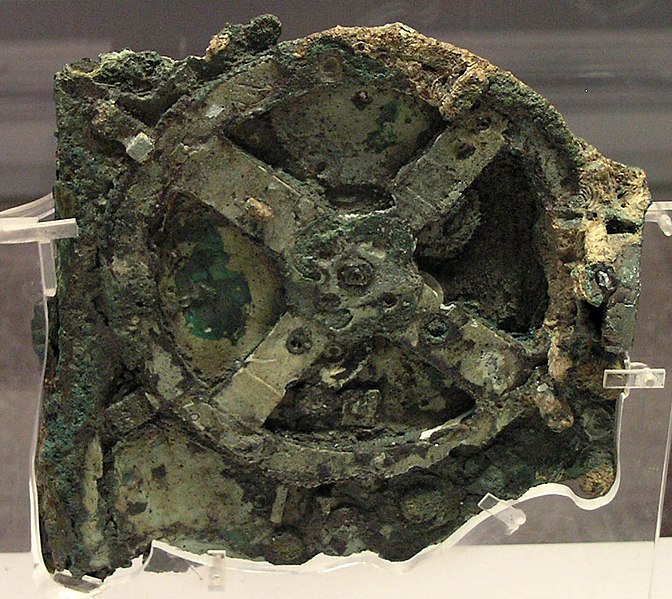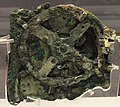Պատկեր:NAMA Machine d'Anticythère 1.jpg

Նախադիտման չափ՝ 672 × 599 պիքսել։ Այլ թույլտվությաններ: 269 × 240 պիքսել | 538 × 480 պիքսել | 861 × 768 պիքսել | 1036 × 924 պիքսել.
Սկզբնական նիշք (1036 × 924 փիքսել, նիշքի չափը՝ 207 ԿԲ, MIME-տեսակը՝ image/jpeg)
Նիշքի պատմություն
Մատնահարեք օրվան/ժամին՝ նիշքի այդ պահին տեսքը դիտելու համար։
| Օր/Ժամ | Մանրապատկեր | Օբյեկտի չափը | Մասնակից | Մեկնաբանություն | |
|---|---|---|---|---|---|
| ընթացիկ | 10:48, 20 Դեկտեմբերի 2005 |  | 1036 × 924 (207 ԿԲ) | Marsyas | Fragment principal de la machine d'Anticythère. Le mécanisme consiste en un système complexe de 32 roues et plaques portant des inscriptions relatives aux signes du zodiac et aux mois. L'étude des fragments suggère qu'il s'agissait d'une sorte d'astr |
Նիշքի օգտագործում
Հետևյալ 4 էջերը հղվում են այս նիշքին՝
Նիշքի համընդհանուր օգտագործում
Հետևյալ այլ վիքիները օգտագործում են այս նիշքը՝
- Օգտագործումը ab.wikipedia.org կայքում
- Օգտագործումը af.wikipedia.org կայքում
- Օգտագործումը als.wikipedia.org կայքում
- Օգտագործումը ang.wikipedia.org կայքում
- Օգտագործումը anp.wikipedia.org կայքում
- Օգտագործումը an.wikipedia.org կայքում
- Օգտագործումը ar.wikipedia.org կայքում
- Օգտագործումը ast.wikipedia.org կայքում
- Օգտագործումը azb.wikipedia.org կայքում
- Օգտագործումը az.wikipedia.org կայքում
- Օգտագործումը bcl.wikipedia.org կայքում
- Օգտագործումը be-tarask.wikipedia.org կայքում
- Օգտագործումը be.wikipedia.org կայքում
- Օգտագործումը bg.wikipedia.org կայքում
- Օգտագործումը bn.wikipedia.org կայքում
- Օգտագործումը bs.wikipedia.org կայքում
- Օգտագործումը ca.wikipedia.org կայքում
- Օգտագործումը ce.wikipedia.org կայքում
- Օգտագործումը cs.wikipedia.org կայքում
- Օգտագործումը cv.wikipedia.org կայքում
Տեսնել այս նիշքի ավելի համընդհանուր օգտագործումը:
Մետատվյալներ
🔥 Top keywords: Գլխավոր էջՀայոց ցեղասպանությունՍպասարկող:ՈրոնելՀայոց ցեղասպանության զոհերի հուշահամալիրՀայաստանԿոմիտասՀամո ՍահյանՍևանա լիճԱլեքսանդր ԹամանյանՇառլ ԱզնավուրՀայերենի այբուբենՀովհաննես ԹումանյանՎահան ՏերյանՊարույր ՍևակԳարեգին ՆժդեհԶվարթնոցի տաճարԵղիշե ՉարենցՎիլյամ ՍարոյանՍասունցի ԴավիթԽաչատուր ԱբովյանՎարդանանք (պատմավեպ)ՈրոտանԱրարատՎիկտոր ՀամբարձումյանՍպասարկող:ՎերջինփոփոխություններըՀովհաննես ՇիրազՏիգրան ՊետրոսյանՄարտիրոս ՍարյանՄատենադարանՔութեշՋրծաղիկՄուշեղ ԳալշոյանԵրևանՍասնա ծռերՎբեթՄոնթե ՄելքոնյանՋուրԽաչքարՍուրբ Հովհաննես մատուռ (Հարթագյուղ)
